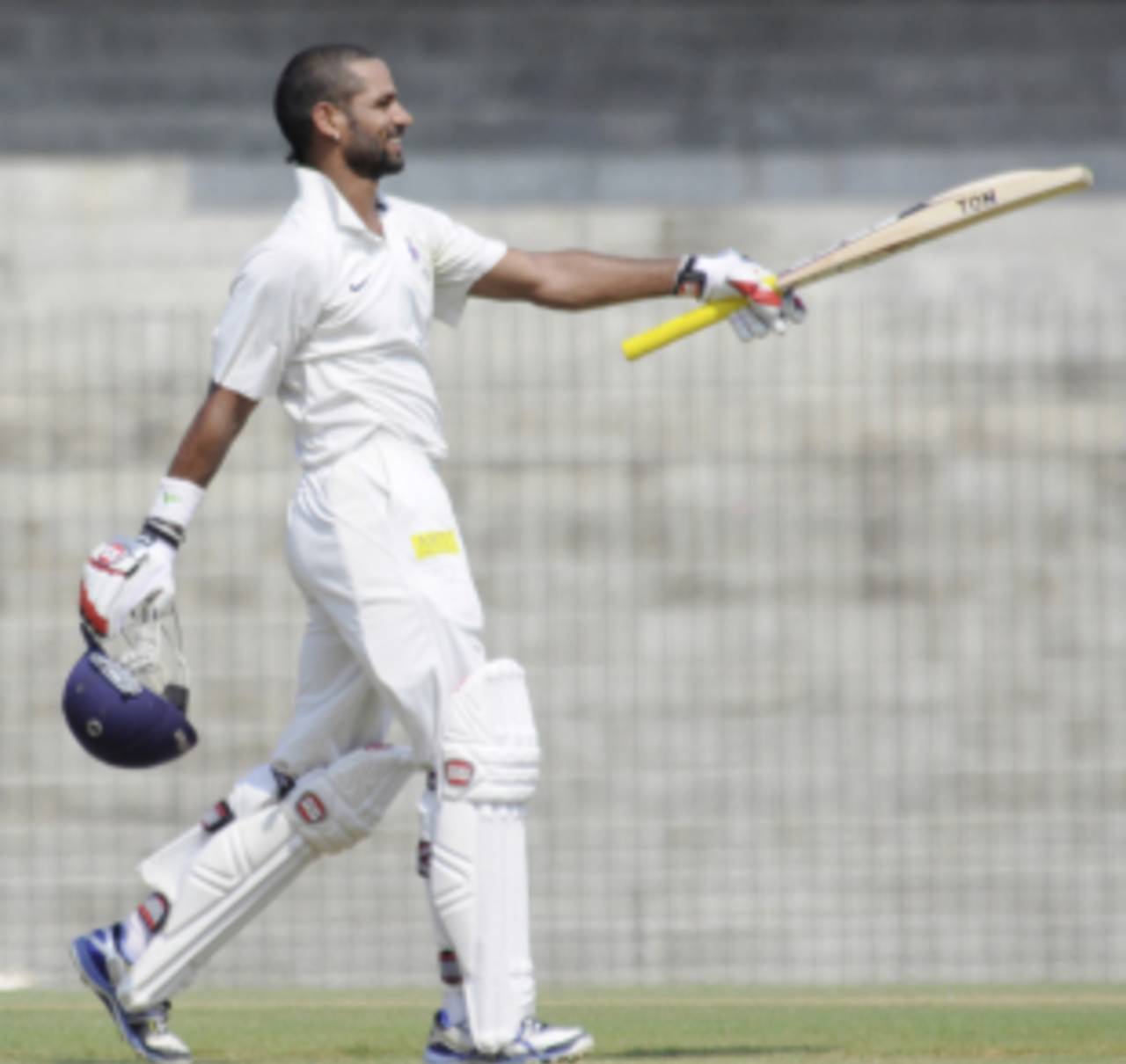The two-day
Gang of Four soap opera has done the implausible: diverted attention from India in India. India will be pleased. Not least
Shikhar Dhawan, who will on Thursday step into the space once occupied by Virender Sehwag - at least, on the scorecard.
Dhawan, 27, is another opener off the production line from Delhi. If Sehwag make-shifted into the position and turned it his own, Aakash Chopra, Gautam Gambhir and now Dhawan have always been fully-certified openers.
Dhawan's move up the order to an India Test spot has come from the poor run of form for both Sehwag and Gambhir. Until now, Dhawan has had to bide his time through the better part of nine years in first-class cricket, due to Sehwag and Gambhir's occupation of the opening slots, and the crests and troughs of his own career. This season, though, Dhawan finds himself on a crest that he hopes will last longer.
His inclusion in the Indian team, before the series against Australia, came on the back of 833 first-class runs at 55.53, which included four hundreds and three fifties. This is Dhawan's most prolific season, and in it, his colleagues and coaches see signs of maturity, which should help him tide over what have so far been his turbulent twenties.
A free-stroking left-hand batsman with dazzling shots square of the wicket, Dhawan is at his best when playing freely. His Delhi team-mate, Rajat Bhatia, says that over the last few seasons he has seen "a much more mature player who understands the importance of big runs". Another Delhi player, Mithun Manhas, says Dhawan's appetite for big scores has only grown. "He is focused on his game, and knows how to take care of his weaknesses, as much as he concentrates on his strengths," Manhas said.
Delhi coach Vijay Dahiya tells a story of two seasons, and specifically two matches, both at Delhi's most seamer-friendly venue, the Roshanara Club Ground. In December 2010, Delhi had to score
136 in the fourth innings to beat Railways. They muffed the chase, losing by 22 runs, with Dhawan pilloried for his dismissal.
In December 2012, Maharashtra set Delhi a target of 270 at the same venue, where their highest successful chase had been 160. Delhi won by
seven wickets, with Dhawan not out on 116. He was involved in two major partnerships. Dhawan had said to his coach then, "I messed it up the last time. This time I wanted to make sure I didn't."
In Mohali, a ground he is familiar with, Dhawan gets another chance to lift his game even higher. He is famous in India for being the top-scorer and the player of the tournament in the
2004 Under-19 World Cup. Team-mates in that junior squad included Suresh Raina, Robin Uthappa and RP Singh, who have since then played 31 Tests, 255 ODIs and 57 T20 internationals between them.
Dhawan's time with India has been all of five ODIs, and a T20 International in 2011, when he was roped in because of his shot-making skills and extraordinarily high fielding and fitness levels. It turned pear-shaped for him in his brief stint with India, but Dhawan's sudden spurts of performances in domestic cricket have always kept him in the mix. He has been on India A squads to Australia, England and the West Indies over those nine seasons. His best performance on those three tours was his
179 against Yorkshire in a three-day match in 2010.
What was missing from Dhawan's game was a consistent run, across not merely a handful of matches but through entire seasons. His school coach, Madan Sharma, is relieved that Dhawan has begun to convert attractive 60s and 70s into bigger scores.
"He's at an age when batsmen mature, between 26 and 30," Madan said. "While he has always been hard-working, he has learnt tough lessons, and grown to where he now understands how important it is to protect his wicket, and which ball to leave."
The younger Dhawan, according to Sharma, was a careless batsman, who had a "lift-maar-ke-out [lofting-and-getting-out]" approach to batting. He is now gratified to find that the older Dhawan has found what could be the even keel he has been critically missing so far.
Dahiya sees a batsman who has worked on his technique against the short ball, has looked "very solid" on his front foot, and has found a way to be carefree after the frustrations of an unpredictable career. "He's become mentally stronger," Dahiya said.
In an interview earlier this year, Dhawan explained it simply, "I realised that I was not using my brains, but only my talent." He has made it a habit of noting down his observations from a net session or an innings, and going through them during the season. Bhatia has first-hand experience of Dhawan's intensity around his batting from the many discussions after a day's play. About how different batsmen would handle the ball that dismissed him.
Bhatia said: "I would always say to him, 'Don't concentrate so hard on your technique. Concentrate on watching the bowler, watching the ball and on scoring runs.'" Consistently.
Sharda Ugra is senior editor at ESPNcricinfo
